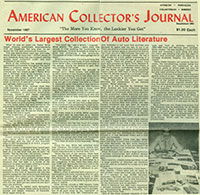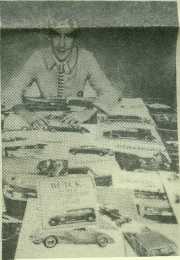
American Collector’s Journal 1987
World’s Largest Collection of Auto Literature
 |
||
|
|
|||
|
When he was six years oid, Walter Miller began clipping automobile advertisements from old magazines. Not long after, he collected his first auto promotional brochure.
That was twenty-seven years ago, and today, Walter Miller has more than 1 million pieces of auto literature, more than any museum, and the largest such collection under one roof anywhere in the world.
Word of.the collection has spread among automobile enthusiasts throughout the world. When a collector wants to find the original showroom brochure for his special car, chances are, he’ll check to see if Walter Miller has it. Although most of his business is conducted as mail order, Miller still favors the customers who come in person and has had many customers from foreign countries stop in when in the U.S. to peruse his huge inventory and perhaps make a purchase.
In fact, Walter Miller receives more than 1,000 inquiries a week from car enthusiasts throughout the world searching for original auto company promotional brochures, catalogs, owner’s and repair manuals, postcards, photographs, poster and auto showroom display items dating back to the 1890s right on through the 1980s.
Miller does not print anything himself, handling only those items that were printed by the automobile companies themselves years ago.
If that sounds more like a hobby than a business to you, the 33-year-old Walter Miller would be the first to agree.
"This is definitely an avocation I turned into a vocation," he admits. "When I started collecting auto ads from old magazines when I was a boy, I had no idea it would turn into this."
"This," as Miller modestly refers to it, is "Walter Miller’s Antique Car Literature," a business that now employs eight people, that has taken Miller to more than 40 countries uuouynoui the world in search of literature, and that has customers in more than 100 countries.
Known among his circles as the "Auto Lit King," Miller admits his parents were less-than-thrilled with the idea of this business when in 1977 he enrolled in an M.B.A. program at McGill University.
"They couldn’t understand how I could want a fancy marketing degree and then turn my back on it to sell what they saw as junk," he recalls. "But by the time I left school, I knew I wasn’t cut out for the corporate world."
So the summer after graduate school Miller took his carton of brochures and other auto literature that had been in a corner of his bedroom for years and began offering it to auto enthusiasts. It wasn’t easy at first.
"It takes a while te get started in this business," Miller states. "People who are interested in this kind of literature fall into two general categories: the hardcore auto literature enthusiasts who collect just the literature; and the owner of a special old car–say, a ’57 Cadillac-who wants all the literature that went with that car. Both are very selective and don’t want just anything."
The only way to satisfy such demanding customers on a regular basis was by building a broader and deeper inventory of literature. Miller began doing so.
|
"You could say I was a fanatic, I suppose," Miller admits. "For years, I spent every free minute of time combing the countryside for auto literature. I’d drive hundreds of miles for a shoe box containing a few brochures. Thousands of miles if there was a garage full of them."
Given this dedication, it’s not surprising that before too long he had boxes of auto literature in his father’s den, in the bedrooms and even in the garage, forcing his parents to park their cars outside in the winter.
"They kind of reached the ‘enough is enough’ point," Miller recalls, "and asked me to return control of their house to them. But the thing about collecting this is that when you’re lucky enough to find it, you’ve got to buy it–no matter how much of it there is-or, you’ve got to drive and get it-.-no matter how little of it there is. Especially given that some of that literature is downright obscure. Take the 1930 Packard catalog, for instance. I have a dozen loyal customers waiting for the next one I find."
Most of Miller’s leads consist of a phone call from a person who’s been cleaning an attic and discovered a box of long forgotten brochures or catalogs.
"I’ll answer anyone who calls or writes," Miller states. "I can tell just from a description of the literature if its something I’m looking for. And I’ll make an offer on the spot. That’s pretty much the way I find it—a little here, a little there."
But every once in a while, Miller uncovers what might best be described as a "Mother Lode" of old auto literature: a house-or-barn-full of brochures, catalogs, manuals and other auto literature.
"The person who has that much of it simply lying around tends to be a bit eccentric," Miller admits. He recalls visiting one person who had
dinner trays neatly piled on his back porch. But his attic and garage were filled with thousands of pieces of auto and motorcyle literature.
"You meet all sorts in this business," Miller says.
Along the way, Miller has collected more than literature. He himself owns several antique cars and collects literature about cars and trucks manufactured in Central New York.
"Since the turn of the century, there have been more than 30 different cars and trucks manufactured in Central New York," Miller notes. "Production wasn’t as dominated by a few companies. In fact, there have been more than 5,000 cars and trucks manufactured in the U.S. since the 1890’s, and nearly every one of them printed some kind of literature to promote their venture."
Miller’s office is adorned with a potpourri of memorabilia and trivia, including what he calls the earliest "vanity plate" on record, a 1903 New Jersey license plate home-made by sewing metal numbers of the driver’s choice onto a piece of leather.
Other rarities include a 1959 Havana, Cuba racing poster from the last race held there prior to Fidel Castro’s rise to power and his cancellation of all such races as too "capitalist" in nature. A 21-foot wide 1941 Oldsmobile out-
|
||
|
|
|||
|
|
|||
|
door billboard in full color that survived only because an agent was too lazy to put it up. There are photos of movie stars and presidents in cars at various races or promotional events. The front end of a 1953 Chrysler has been cut off and serves as a storage closet. He has a 1920 model for a U.S. patent consisting of a wooden arm and hand for use as a primitive turn signal. There are dozens of letters from such auto pioneers as Henry Ford, Ransom E. Olds, Charles Nash, Dr. Porsche and others. A 1959 Ford internal confidential memo stating that the Edsel project was being cancelled. There’s even an 1842 book of the proceedings of the U.S. Senate regarding a proposed crosscountry toll road for steam-powered wagons which were popular at the time.
"That idea–which was voted down-was definitely the predecessor to our freeway system," Miller observes.
Not all of the inquiries for literature that Miller receives are from collectors. Several rock groups and production companies have purchased car brochures while doing research for the production videos featuring old cars. Several police agencies and district attorneys offices have borrowed or purchased auto sales literature to aid in the identification of cars.
Once, a Central New York woman who was brutally murdered was last seen by several witnesses near an old red pickup truck of indefinite make. State Police borrowed several Chevy and Ford truck brochures and used them with the witnesses as an aid to identify the exact truck and, eventually, to apprehend the suspect.
Miller once sold a 1961 Lincoln repair manual to a man in Saudi Arabia. After a few months the man called to say that it had never been received. After some research Miller found that Saudi Arabia had a ban on all Ford products because of their ties with Israel.
So he found an identical manual and proceeded to rip out all pages that had any reference to "Ford" and shipped it. It was delivered intact and a nice thank you followed.
After visiting Jordan some time ago, Miller heard that King Hussein was a collector of certain older Mercedes. He sent some literature on these particular cars to him and asked if he oould see Hussein’s car collection. He has not /et received an invitation.
Steve McQueen had quite a large collection of antique motorcycles and ordered several notorcycle catalogs ar various times over the tears.
More recently, a bank contacted Miller to ask f a large quantity of Delorean car literature xould be used as collateral for a loan on a new Mercedes.
"They were virtually worthless, I told them," filler reports. "There were just so many of hem printed. I even had a man call me once to isk if I wanted to buy 25,000 Delorean irochures. I declined, but was curious why he lad so many. It turned out he was the printer, nd when Delorean went belly up, tie was stuck /ith the brochures and no payment." Miller’s literature has even been requested y lawyers involved with lawsuits regarding uto manufacturing defects, including the amous Ford Pinto fires. "One of the more unusual requests of that
|
type was from an attorney looking for 1950-1980 Ford and Mercury paint samples," Miller recalls. "He was handling a multi-million dollar suit involving a toxic dump site where his client was alleging that over the years the factory that produced paint for Mercury had dumped excesses illegally. It’s still in the :ourts."
While these requests are certainly the more axotic, the overwhelming number come from auto enthusiasts and collectors of auto literature, some of whom seek not only the brochure of a particular car in a particular year, but also each printing of the brochure.
"Some of the auto brochures were re-printed several times in a year, " Miller acknowledges. "The auto company would add a chrome stripe, and all of the photos or illustrations would change. Each change required another printing. And the real enthusiast wants every single printing of a given brochure. I have a great many in inventory."
Miller ultimately views himself as something of a middleman when it comes to literature.
"I guess what this business is all about is giving this literature new life," he states. "I find it lying around somewhere, unknown and unappreciated, and collect it in one spot for the enthusiasts."
More often than not, those enthusiasts find the literature they’re searching for at Walter Miller’s Antique Auto Literature. And, who knows, if you’ve got a box of that auto literature in your attic, you should give him a call. You might be surprised what it’s worth.Walter Miller can be reached at (315)432-8282.
|
||
 |
|||
|
|
|||


